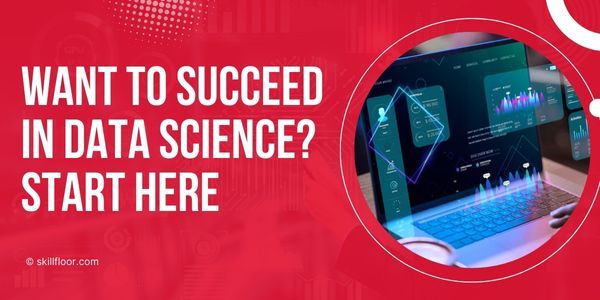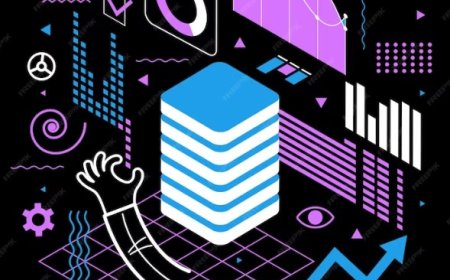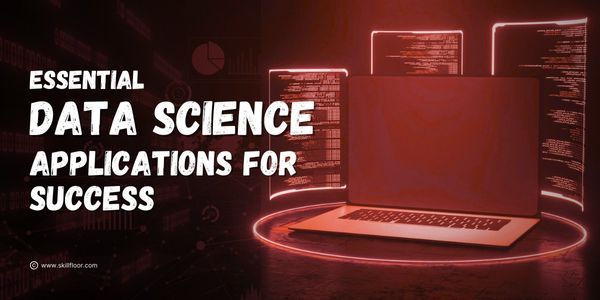What Are the Prerequisites for Data Science?
Learn the key prerequisites for data science, including programming, math, and data visualization, to build a solid foundation for a successful career.

I was impressed with data science's ability to show hidden insights from complex datasets when I first started learning about it. However, the path wasn't easy; I realized that my interest wasn't sufficient on its own. I got stuck with statistical concepts and technical language without the proper fundamental skills. That's when I realized how important it is to understand the prerequisites for data science to develop a strong base of knowledge.
Data science has applications in almost every business, making it one of the most sought-after careers today. Data science offers countless opportunities, whether your goal is to predict trends, improve customer experiences, or strengthen business strategies. It is important to understand the prerequisites for data science to achieve real success. Let's go through each essential skill in this article, providing advice on how to get ready for an exciting career in data science.
What is Data Science?
For the purpose of gaining valuable insights from data, the multidisciplinary area of data science includes computer science, statistics, and expertise in the field. Data science is basically the act of collecting, cleaning, assessing, and understanding data in order to make wise judgments.
Let's look at an example: Data science is used by an online retail platform to understand customer behaviour. A customer's clicks, searches, and purchases are all recorded and tracked. Businesses can use data science to evaluate this data and provide recommendations for relevant items, predict future demand, and personalize the user experience. In this case, data science turns unstructured, seemingly unorganized data into useful insights that support the success of enterprises.
The following example shows how data science impacts a range of industries, including healthcare, banking, entertainment, and sports. However, mastering the prerequisites for data science is necessary to become an expert in this order.
Why Are Prerequisites Important for Data Science?
There are many tools and methods available in the broad topic of data science. Confusion, lack of sleep, and frustration can result from starting without a well-defined plan. Understanding the prerequisites for data science allows you to:
-
Build a Solid Foundation: Basic ideas in statistics, programming, and mathematics provide the framework for comprehending more complex subjects like data engineering and machine learning.
-
Learn Effectively: Mastering more complex methods is easier when you have a strong foundation.
-
Enhance Career Readiness: Data scientists should be proficient in programming, machine learning, data manipulation, and visualization, according to employers. Gaining proficiency in these areas increases your marketability.
-
Adapt to Industry Changes: Since data science is always changing, it's easier to stay up to date with new tools and trends if the fundamentals are understood.
5 Prerequisites for Data Science
The most important prerequisites for data science are organized down below by skill category.
1. Mathematics and Statistics
The basis of data science is made up of statistics and mathematics. They offer the framework for understanding data, creating models, and analyzing results.
Linear Algebra:
-
Understanding algorithms, especially those involved in data transformation and machine learning, requires a solid understanding of linear algebra.
-
Important subjects include eigenvalues, vectors, matrices, and matrix multiplication. These ideas are essential for algorithms that reduce the dimensions of data, such as Principal Component Analysis (PCA) and Singular Value Decomposition (SVD).
Calculus:
-
Understanding the operation of optimization algorithms requires a strong understanding of calculus, particularly differential calculus. For example, derivatives play a key role in gradient descent, which reduces mistakes in machine learning models.
-
Important subjects that help in understanding and improving model behaviour are derivatives, integrals, and partial derivatives.
Statistics and Probability:
-
Data scientists use statistics to test hypotheses, draw conclusions, and make inferences from data.
-
The central limit theorem, hypothesis testing, confidence intervals, probability distributions, and Bayesian inference are important subjects. These ideas enable data scientists to make data-driven decisions, analyze estimates, and measure uncertainty.
2. Programming Skills
Data scientists need to know how to program. It enables efficient data handling, analysis, and modelling.
Python:
-
Python is the preferred language for data science because of its vast libraries, including Pandas, NumPy, Scikit-learn, and TensorFlow, as well as its ease of use and readability.
-
Use cases: Python can be applied to statistical analysis, machine learning model development, data cleansing, and visualization.
R:
-
R is particularly well-liked in educational institutions and businesses that depend significantly on statistical analysis. It is renowned for its strong data analysis and visualization packages.
-
Use cases: R is perfect for research-based data analysis, statistical modelling, and visualizations.
SQL:
-
In relational databases, SQL (Structured Query Language) is essential for accessing and modifying data. Since databases hold the majority of real-world data, SQL is an essential tool for data extraction.
-
Examples of use: SQL allows you to work with massive datasets by performing aggregations, joining tables, and searching databases.
Version Control (Git):
-
Git facilitates efficient teamwork and code change management for data scientists.
-
Use cases: Git makes it easy to collaborate with others, log changes, and roll back to earlier iterations.
3. Data Manipulation and Analysis
Cleaning and converting unstructured data into an analysis-ready format are steps in the data manipulation and analysis process.
Data Cleaning:
-
Data from the real world is frequently messy, with duplicates, outliers, and missing values. Your analysis will be reliable and accurate if your data is cleaned.
-
Tools: Data cleansing commonly uses R's dplyr package and Python packages like Pandas.
Exploratory Data Analysis (EDA):
-
To find patterns, identify defects, and formulate hypotheses, EDA involves analyzing datasets and utilizing visualization.
-
Tools: Visualizing distributions, observing connections with scatter plots, and producing summary statistics are common EDA methods.
Feature Engineering:
-
Feature engineering is the process of turning unstructured data into useful features that improve model performance and accuracy.
-
Examples include encoding categorical variables for machine learning models or developing a "time since last purchase" feature for predicting client loss.
4. Machine Learning
Data scientists can develop prediction models due to machine learning. To create models and make predictions, one must have a fundamental understanding of machine learning.
Supervised Learning:
-
Labelled data is necessary for supervised learning to project results based on past events. Decision trees, logistic regression, and linear regression are examples of algorithms.
-
Example: Estimating the cost of a home based on characteristics such as location, area, and number of rooms.
Unsupervised Learning:
-
Without labelled results, unsupervised learning algorithms reveal hidden patterns in data. Typical methods include dimensionality reduction (e.g., PCA) and clustering (e.g., K-means).
-
Example: Grouping clients according to their purchase patterns.
Model Evaluation and Validation:
-
Model evaluation is the process of evaluating a machine learning model's performance to make sure it performs well when applied to new data.
-
Important metrics: When assessing classification models, measures like precision, recall, F1 score, and ROC-AUC are frequently employed. Cross-validation is a method for evaluating the performance of models.
Deep Learning:
-
Understanding deep learning may be helpful for advanced data science positions, especially if you're dealing with big datasets or challenging issues like language and image processing.
-
Frameworks: Two well-liked options for creating neural networks are TensorFlow and PyTorch.
5. Data Visualization
Visualizing data is essential for sharing insights. Stakeholders are better able to understand data-driven findings when visualization is done well.
Tools and Libraries:
-
Matplotlib, Seaborn, and Plotly are Python libraries.
-
Platforms: Two well-liked programs for making interactive dashboards are Tableau and Power BI.
Principles of Visualization:
-
Clear, concise data visualization highlights the main point. Selecting the appropriate chart kinds and avoiding clutter is important.
-
Examples include scatter plots to display relationships, line graphs for trends, and bar charts for categorical comparisons.
Additional Prerequisites for Aspiring Data Scientists
Success in data science is influenced by several other requirements in addition to technical proficiency:
Domain Knowledge
A thorough understanding of the particular business you operate in, such as retail, healthcare, or finance, is known as domain expertise. It helps data scientists place their analyses in context and produce important, useful insights.
-
Importance: For example, in order to make ethical and successful data judgments, a healthcare data scientist must be familiar with clinical terminology and patient confidentiality requirements.
-
For example, knowing ideas like seasonal demand, pricing strategies, and customer attrition would increase the practicality of data analysis in the retail industry.
Communication Skills
Non-technical stakeholders must be presented with complex findings by data scientists. Effective communication is important for converting data insights into business choices that can be implemented.
-
Importance: Effective communication facilitates communication between decision-makers and data science teams. It ensures the clear and effective presentation of technical results.
-
Examples include simplifying statistical results for company executives or employing storytelling strategies in data presentations.
Curiosity and Solving Problems
Addressing real-world issues is the focus of data science, and an inquisitive, analytical approach is crucial. Data scientists who are curious are better able to examine data in depth, challenge presumptions, and come up with original solutions.
-
Importance: Curiosity motivates you to test theories, investigate various strategies, and never stop learning.
-
For example, an interested data scientist can look into outliers to find surprising patterns rather than taking a dataset at face value.
Learning Path to Meet the Prerequisites
Here is a detailed path to help you learn the prerequisites for data science if you're ready to get started:
Start with Mathematics and Statistics: Begin by learning the fundamentals of mathematics and statistics using sites like YouTube, Coursera, and Khan Academy.
Learn a Programming Language: Python is a good choice for beginners because it is flexible and easy to use. Finish little tasks to help you remember what you've learned.
Understand Data Manipulation: Learn about data manipulation by using SQL and Pandas to clean and analyze datasets.
Dive into Machine Learning: Examine more complex tools like TensorFlow after starting with simpler libraries like Scikit-learn.
Learn Data Visualization: To improve your storytelling abilities, make dashboards and graphs for datasets.
Work on Real-World Projects: Use your expertise on datasets related to your field of interest, recording your steps and results.
Frequently Asked Questions
Q1: Can I learn data science without a formal degree?
Really! Although having a degree is helpful, many effective data scientists learn on their own. Excellent substitutes include boot camps, online courses, and practical projects.
Q2: Do I need advanced mathematics for data science?
For most roles, a basic to advanced understanding of mathematics is sufficient. Advanced skills, however, could be necessary for specific roles like deep learning engineering
Q3: How long does it take to master the prerequisites?
Your learning style and experience will determine this. It typically takes 6 to 12 months to learn the fundamentals and an additional six to twelve months to obtain real-world experience.
It needs a combination of hard and soft talents to succeed in data science. You'll be ready to handle the complicated world of data if you concentrate on the prerequisites for data science, which range from math and programming to communication and domain expertise. Although learning data science is a lifelong process, if you start with a strong basis, you'll be ready to take on the difficulties and benefits of this exciting field of study. Keep in mind that every step you take to fulfil these requirements will get you one step closer to being a skilled and effective data scientist.




























































